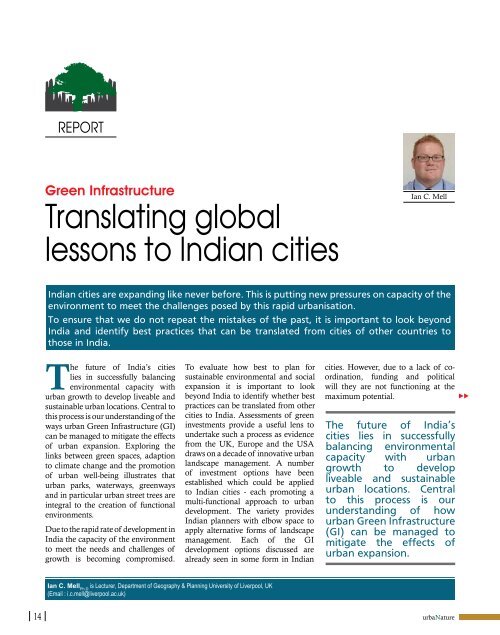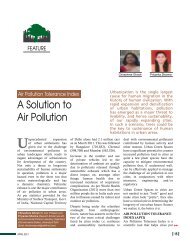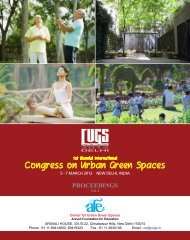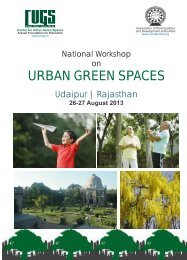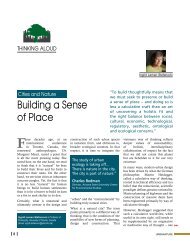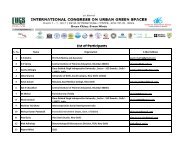eport<strong>Green</strong> InfrastructureTranslating globallessons to Indian citiesIan C. MellIndian cities are exp<strong>and</strong>ing like never be<strong>for</strong>e. This is putting new pressures on capacity of <strong>the</strong>environment to meet <strong>the</strong> challenges posed by this rapid urbanisation.To ensure that we do not repeat <strong>the</strong> mistakes of <strong>the</strong> past, it is important to look beyondIndia <strong>and</strong> identify best practices that can be translated from cities of o<strong>the</strong>r countries tothose in India.The future of India’s citieslies in successfully balancingenvironmental capacity withurban growth to develop liveable <strong>and</strong>sustainable urban locations. Central tothis process is our underst<strong>and</strong>ing of <strong>the</strong>ways urban <strong>Green</strong> Infrastructure (GI)can be managed to mitigate <strong>the</strong> effectsof urban expansion. Exploring <strong>the</strong>links between green spaces, adaptionto climate change <strong>and</strong> <strong>the</strong> promotionof urban well-being illustrates thaturban parks, waterways, greenways<strong>and</strong> in particular urban street trees areintegral to <strong>the</strong> creation of functionalenvironments.Due to <strong>the</strong> rapid rate of development inIndia <strong>the</strong> capacity of <strong>the</strong> environmentto meet <strong>the</strong> needs <strong>and</strong> challenges ofgrowth is becoming compromised.To evaluate how best to plan <strong>for</strong>sustainable environmental <strong>and</strong> socialexpansion it is important to lookbeyond India to identify whe<strong>the</strong>r bestpractices can be translated from o<strong>the</strong>rcities to India. Assessments of greeninvestments provide a useful lens toundertake such a process as evidencefrom <strong>the</strong> UK, Europe <strong>and</strong> <strong>the</strong> USAdraws on a decade of innovative urbanl<strong>and</strong>scape management. A numberof investment options have beenestablished which could be appliedto Indian cities - each promoting amulti-functional approach to urb<strong>and</strong>evelopment. The variety providesIndian planners with elbow space toapply alternative <strong>for</strong>ms of l<strong>and</strong>scapemanagement. Each of <strong>the</strong> GIdevelopment options discussed arealready seen in some <strong>for</strong>m in Indiancities. However, due to a lack of coordination,funding <strong>and</strong> politicalwill <strong>the</strong>y are not functioning at <strong>the</strong>maximum potential.The future of India’scities lies in successfullybalancing environmentalcapacity with urbangrowth to developliveable <strong>and</strong> sustainableurban locations. Centralto this process is ourunderst<strong>and</strong>ing of howurban <strong>Green</strong> Infrastructure(GI) can be managed tomitigate <strong>the</strong> effects ofurban expansion.Ian C. Mell Ph.Dis Lecturer, Department of Geography & Planning University of Liverpool, UK(Email : i.c.mell@liverpool.ac.uk)14 urbanature
<strong>Green</strong> InfrastructureTranslating global lessons to Indian citiesCITY-SCALE PARKS AND GARDENSMost global cities are home to at leastone green space that is deemed to beof city-scale importance. Central Park(New York, USA), Parc de Villette(Paris, France) <strong>and</strong> The Gardensby <strong>the</strong> Bay (Singapore) all act asmagnets <strong>for</strong> local people, businesses<strong>and</strong> tourists. What <strong>the</strong>y offer are largemulti-functional spaces providingrespite from urban environment. Eachwas planned to contain a combinationof water, physical infrastructure <strong>and</strong>l<strong>and</strong>scaping options. The impact of<strong>the</strong>se spaces has been in terms ofestablishing locations that are centralto <strong>the</strong> economic <strong>and</strong> social value ofits host city. <strong>City</strong>-scale investments<strong>the</strong>re<strong>for</strong>e provide valuable economicreturns on investment, as well as arange of social well-being benefits.Supporting city-scale investmentswith a tiered system of smaller greenspaces also enables planners to developintegrated green networks across widerurban areas; Copenhagen (Denmark)<strong>and</strong> Dortmund (Germany) aresuccessful examples of this process.New Delhi Trees signageURBAN TREESThe role of urban street treesis disproportionate to <strong>the</strong>irperceived value. Street trees offer acomprehensive <strong>for</strong>m of urban greeningby adapting urban environments toclimate change, promoting betterphysical <strong>and</strong> mental health, mitigateurban pollution <strong>and</strong> support a widerange of economic activities (i.e. treecommerce).Evidence from five UK<strong>and</strong> European cities indicated thatstreet tree investments encourageeconomic returns in far excess ofimplementation costs (Manchester£24+ pppy; Esslingen €11+ pppy).Research undertaken in <strong>the</strong> Newcastle(UK) <strong>and</strong> Bari (Italy) highlighted <strong>the</strong>restorative value of trees <strong>for</strong> personalhealth. Whilst <strong>for</strong>est managers inIndianapolis <strong>and</strong> New York (bothUSA) calculated <strong>the</strong> value of streettrees to <strong>the</strong> local economy, identifyingthat in both locations <strong>the</strong> return oninvestment ran into millions of dollarswhich could be directly attributedto trees. Fur<strong>the</strong>r evidence fromManchester (UK) also highlights <strong>the</strong>role of trees in interception pollution,mitigating temperature (between5-15 0 C change), as well as aiding<strong>the</strong> ability of urban water systems tomitigate extreme wea<strong>the</strong>r events.RETRO-FITTING BROWNFIELD SITESRecently one of <strong>the</strong> most successful<strong>for</strong>ms of GI investment has beenretrofitting brownfield sites. TheHigh Line (New York, USA) utiliseda derelict rail track to reinvigorate<strong>the</strong> Lower West side; <strong>the</strong> OlympicPark in London reclaimed 2.5km 2of contaminated l<strong>and</strong> in EastLondon into commercial <strong>and</strong> socialuse; <strong>and</strong> in Detroit (USA) tracts ofdisenfranchised housing has beenreimagined as sites <strong>for</strong> large-scaleurban agriculture. The link betweeneach investment is based upon a reevaluationof undervalued l<strong>and</strong> to<strong>for</strong>m functional urban GI networks.Although <strong>the</strong> scales differ, <strong>the</strong> primaryfocus of each investment has beento create accessible, functional, <strong>and</strong>most importantly, hybrid green spaceswithin heavily urbanised locations.MANAGEMENT OF URBAN GIIn London (UK), New York <strong>and</strong>Philadelphia (both USA), <strong>and</strong>Amsterdam (Holl<strong>and</strong>) <strong>the</strong>re arecredible management agenciespromoting urban greening thatwork alongside engaged advocacystakeholders. The benefit of this is <strong>the</strong>establishment of a range of integratedmanagement plans which identifystrategic investment sites. To ensurethis system is successful each cityhas earmarked funding to supportthis process. The combination ofappropriate funding <strong>and</strong> knowledgemanagement aligned with ecological,water <strong>and</strong> climatic expertise enableseach city to maintain its green spaces asecologically functional, whilst creatinglocations <strong>for</strong> social <strong>and</strong> economicinvestments. Working within suchan environment facilitates a moreengaged dialogue between advocacygroups, political structures <strong>and</strong> localJuly 201315


